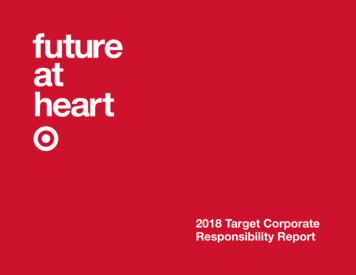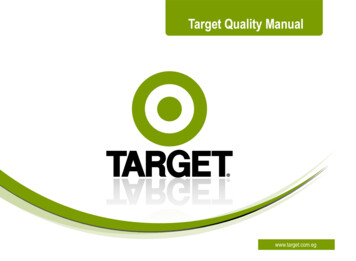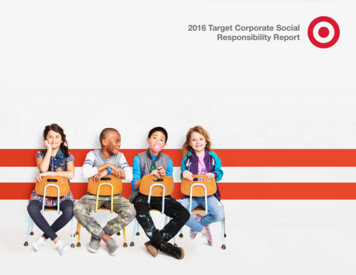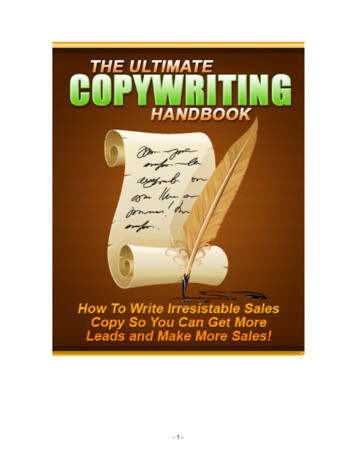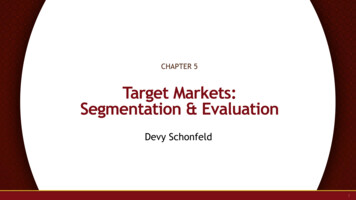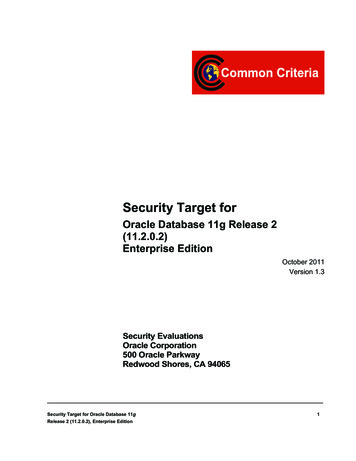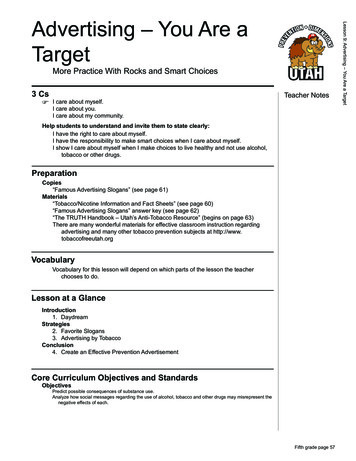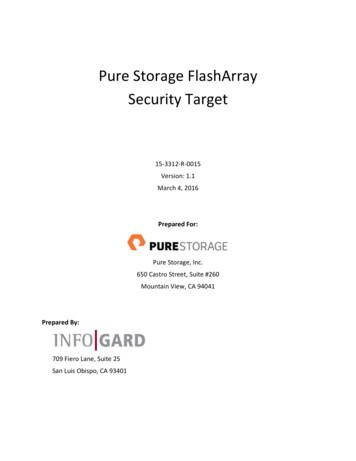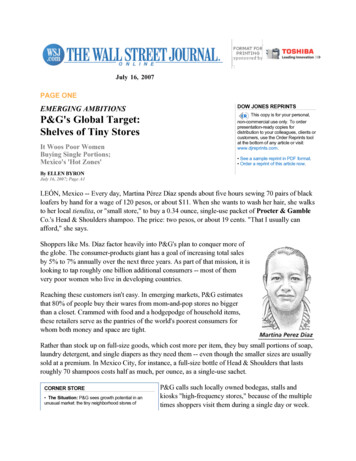
Transcription
July 16, 2007PAGE ONEEMERGING AMBITIONSP&G's Global Target:Shelves of Tiny StoresIt Woos Poor WomenBuying Single Portions;Mexico's 'Hot Zones'DOW JONES REPRINTSThis copy is for your personal,non-commercial use only. To orderpresentation-ready copies fordistribution to your colleagues, clients orcustomers, use the Order Reprints toolat the bottom of any article or visit:www.djreprints.com. See a sample reprint in PDF format. Order a reprint of this article now.By ELLEN BYRONJuly 16, 2007; Page A1LEÓN, Mexico -- Every day, Martina Pérez Díaz spends about five hours sewing 70 pairs of blackloafers by hand for a wage of 120 pesos, or about 11. When she wants to wash her hair, she walksto her local tiendita, or "small store," to buy a 0.34 ounce, single-use packet of Procter & GambleCo.'s Head & Shoulders shampoo. The price: two pesos, or about 19 cents. "That I usually canafford," she says.Shoppers like Ms. Díaz factor heavily into P&G's plan to conquer more ofthe globe. The consumer-products giant has a goal of increasing total salesby 5% to 7% annually over the next three years. As part of that mission, it islooking to tap roughly one billion additional consumers -- most of themvery poor women who live in developing countries.Reaching these customers isn't easy. In emerging markets, P&G estimatesthat 80% of people buy their wares from mom-and-pop stores no biggerthan a closet. Crammed with food and a hodgepodge of household items,these retailers serve as the pantries of the world's poorest consumers forwhom both money and space are tight.Rather than stock up on full-size goods, which cost more per item, they buy small portions of soap,laundry detergent, and single diapers as they need them -- even though the smaller sizes are usuallysold at a premium. In Mexico City, for instance, a full-size bottle of Head & Shoulders that lastsroughly 70 shampoos costs half as much, per ounce, as a single-use sachet.CORNER STORE The Situation: P&G sees growth potential in anunusual market: the tiny neighborhood stores ofP&G calls such locally owned bodegas, stalls andkiosks "high-frequency stores," because of the multipletimes shoppers visit them during a single day or week.
developing countries. The Background: In emerging markets, P&Gestimates as many as 80% of people buy their waresfrom such mom-and-pop stores. Next Step: Getting better shelf space in the shops.Though most are rudimentary, usually operating out ofthe owner's home, these shops are a vital route intodeveloping markets, executives believe. But while P&Gestimates there to be about 20 million high-frequencystores world-wide, so far just 2.5 million carry theirproducts.Over the past six years, P&G has been deploying its armies of researchers, product developers andmerchandising wizards to better understand both high-frequency-store shoppers, owners and thehaphazard distributor networks that stock them.For P&G the stakes are high. Sales of P&G products in developing markets currently total 20billion, up from 8 billion five years ago. In recent years, emerging markets have contributed about40% of the company's "organic" sales growth, which excludes gains from acquisitions. Thecompany still lags other consumer-product rivals. Last year P&G derived 26% of sales in theseregions -- a far cry from Unilever and Colgate-Palmolive Co., which manage to snag about 40% oftheir business in developing markets.Many industry observers initially believed that these independently owned shops would die out asmajor retailers such as Wal-Mart Stores Inc. and United Kingdom-based Tesco PLC expandedtheir reach into developing markets. Instead, P&G saw the opposite happen. Today, high-frequencystores, considered in aggregate, are P&G's largest customer, with Wal-Mart coming in second.As these countries' economies have grown, more tiny stores have popped up to serve theircustomers' rising fortunes. The buy-in-bulk mentality which had made mass-merchants roll oversmaller stores in the U.S. simply didn't apply. "That was a paradigm shift for us," says P&G ChiefOperating Officer Robert McDonald. "We'll be in those big-box stores, but we've also got to be inthe small ones."Though Mexico is one of Wal-Mart's most successfulmarkets, high-frequency stores are still regularly visited by70% of the population, P&G estimates. By the company'scount, Mexico has 620,000 high-frequency stores. In mostvillages and cities there is one approximately everyone-and-a-half blocks. Though the average shopper spendsjust 23 pesos, or 2.14, a day in high-frequency stores, annualsales total about 16 billion.Selling products through these stores requires a special set ofskills.Product visibility, for instance, is one of the biggest challengesto selling in high-frequency stores. Shops tend to be poorly litand in Latin America average just 250 square feet in size,P&G found. To store owners, displaying P&G staples like
household cleaners, bath soaps and shampoos isn't a priority.Those types of products typically represent just 10% of their sales, while food brings in 35%, andsoda brings in 25%. To maximize space, shopkeepers often store laundry detergent, toilet-paper rollsand shampoo packets beneath the counter, handing them to shoppers only upon request.So P&G began lobbying for better shelf space, one tiny store at a time, by offering them specialperks that rivals do not. P&G-employed merchandisers visit the stores about every two weeks totidy the shelves of their products, post signs with the items' prices and hand out promotional items,including posters. Also, sales representatives deliver inventory to stores themselves, often sparingowners a trip to the local distributor.P&G touts other advantages, too: Household cleaners and beauty products bring a higher profitmargin than food, candy and soda. And when products are arranged as P&G suggests, sales ofthose items increases 29%, the company claims to owners.Five years ago, it launched a "golden store" program toencourage owners to display P&G products moreprominently. As part of the initiative, representatives visitthe stores to spruce up the shelves and display marketingmaterials -- small touches store owners say they like. To beconsidered a golden store in Mexico, retailers must agree tocarry 40 or so P&G products -- displayed together ratherthan next to competing brands. So far, about 220,000 havethe designation.To prompt even more sales of its products, P&G begandistributing a magazine called "Tu Negocio," or "YourBusiness." Reserved for golden store owners, thepublication explains the benefits of the company's products. It also offers basicbusiness-management tips, including how to calculate profit margins on the items the stores sell.High-frequency stores in Asia, including this one in thePhilippines, often hang products from the ceiling; thisfall, P&G will try such arrangements in Latin America.Recently, José Ramón Riestra, P&G's director of high-frequency stores in Latin America, droppedby a golden store in León. Immediately, he noticed that several P&G products, including Pampersdiapers and Camay soap, were placed along a side wall -- on shelves below waist-level inside aglass case. Since most shoppers tend to linger for less than 60 seconds, they likely wouldn't noticethe goods.Smiling as he introduced himself to Rocío Vazquez, a shy 19-year-old at the counter, Mr. Riestracomplimented her on her family's store. Ms. Vazquez estimates about 90 people from theneighborhood shop there every day, often two or three times. After inquiring generally about sales,Mr. Riestra got to the real business at hand. "Why are our products so far away, over there?" heasked, pointing to a side wall. "Why not put them behind you?"P&G calls space nearest the cashier the "hot zone," and considers it the most valuable real estate inthese small stores. Since more than 60% of customers already know what they're going to buy,
P&G figures, little time is spent browsing. But P&G researchers found that shoppers tend to gaze atthe cashier's area for a precious five seconds as they wait for the owner to hand them a product orget their change -- a prime opportunity to influence future purchases.Despite Mr. Riestra's request for better placement, Ms. Vazquez didn't budge. "We're known locallyas a food store," she says, pointing to the potato chips, candy and a bowl of Hershey's Kisses,priced two for a peso, or about nine cents, that occupied the space that Mr. Riestra wanted.Next, Mr. Riestra and a P&G sales representative tried to persuade Ms. Vazquez to carry anadditional version of Ace detergent, called Ace Natural. Containing aloe, the detergent promises tomake washing clothes by hand gentler on skin. Usually high-frequency stores carry just one or twobrands of detergent, so persuading shopkeepers to take on an additional version of a brand theyalready sell is difficult."Tell your customers this will be better for their hands," Mr. Riestra says, pointing to the Ace bag'sillustration of an aloe plant. He also noted that the price, 4.50 pesos, or 42 cents, is a peso less thanthe regular version of Ace she already carries.On this score he had better luck. Ms. Vazquez agreed to carry a few packages of the new detergent.Initially, P&G had its own exclusive sales force in Mexico to supply storeowners with its products. Then, two years ago, the company decided thatit lacked the scale and resources to maximize distribution -- especially infar-flung regions. P&G began offering basic sales training to independentagents and encouraged them to build their own teams. Today, the companyis experimenting with allowing agents and their workers to earncommissions from markups on products sold to stores.By relying on local agents, P&G is also able to strengthen its ties to storeowners. This is especially important, since owners can be very influentialin the brands their customers choose.Mexican high-frequency store,showing a 'golden store'arrangement of P&G products.Though the agents' jobs can be lucrative, the barriers to entry are high.Each must buy his or her own inventory up front, paying in cash. Topurchase his first supply of P&G products last year, Luis Mosqueda says he sold nearly all of hisfamily's furniture, his car, his children's toys and his mother's gold jewelry. Now, he says he earnsabout 24,000 a year -- an income that makes him relatively affluent. Twelve sales representativeswork for him, including two of his brothers.In marketing goods to low-income shoppers, P&G tries to keep in mind their budget constraints andeven the coins they carry. Because they are often paid a daily wage, Mexican customers generallycarry five- and 10-peso coins. "If you want to sell to low-income consumers, you have to knowwhat's in their pockets," Mr. Riestra says. "It doesn't make sense to have something cost 11 or 12pesos."
To ensure satisfactory profit margins, P&G uses what it calls "reverse engineering." Rather thancreate an item, and then assign a price to it -- as in most developed markets -- the company firstconsiders what consumers can afford. From there, it adjusts the features and manufacturingprocesses to meet various pricing targets. To hold down the cost of its Ace Natural detergent, usedto hand-wash clothes, P&G reduced the amount of enzymes in the product. The result: a product thatcosts a peso less than regular Ace and is gentler on skin.P&G says that reverse engineering helps to keep the company's after-tax margins "comparable" tothose in wealthier, developed countries.Internally, P&G emphasizes to its employees that products developed for emerging markets must"delight, not dilute." Quality, executives say, is still critical. "You cannot trick a low-incomeconsumer, because they can't afford to buy products that don't work," says Mr. Riestra. If a productdoesn't perform, "they won't ever buy you again, and they'll tell everyone they know about it, too."The company has addressed this point in several ways. Running water, for example, is in shortsupply for many low-income Mexican consumers. In response, P&G developed a fabric softener,Downy Single Rinse. It can be added to a load of laundry along with detergent to eliminate an entirerinse cycle in the semiautomatic machines typically used here.Other observations of the crowded quarters in which many poor Mexican people reside have led tolucrative insights about feminine-hygiene products. With women usually lacking the money andprivacy to change their pads frequently, P&G developed Naturella, a low-priced, extra-absorbentcotton pad scented with chamomile, which has soothing and feminine connotations in LatinAmerica.Driven by strong sales in high-frequency stores, Naturella propelled P&G to take the lead infeminine care in Mexico, and is now sold in other developing markets, including Russia, Poland andthe Balkans.This September, P&G plans to bring to Latin America a merchandising technique common in thetiny shops of Asia: hanging products from the ceiling. Finding that dangling items can catchshoppers' attention more than products sitting on shelves, Mariano Martin, P&G's global customerbusiness development officer, issued a directive to his team: "Own the air.""The ceiling is still a very virgin location," says Christiane Rizk, a research specialist forhigh-frequency stores. "We have to get there before someone else does."Write to Ellen Byron at ellen.byron@wsj.com1URL for this 42967244.htmlHyperlinks in this Article:(1) mailto:ellen.byron@wsj.com
Copyright 2007 Dow Jones & Company, Inc. All Rights ReservedThis copy is for your personal, non-commercial use only. Distribution and use of this material are governed by ourSubscriber Agreement and by copyright law. For non-personal use or to order multiple copies, please contact Dow Jones Reprintsat 1-800-843-0008 or visit www.djreprints.com.
Five years ago, it launched a "golden store" program to encourage owners to display P&G products more prominently. As part of the initiative, representatives visit the stores to spruce up the shelves and display marketing materials -- small touches store owners say they like. To be considered a golden store in Mexico, retailers must agree to
